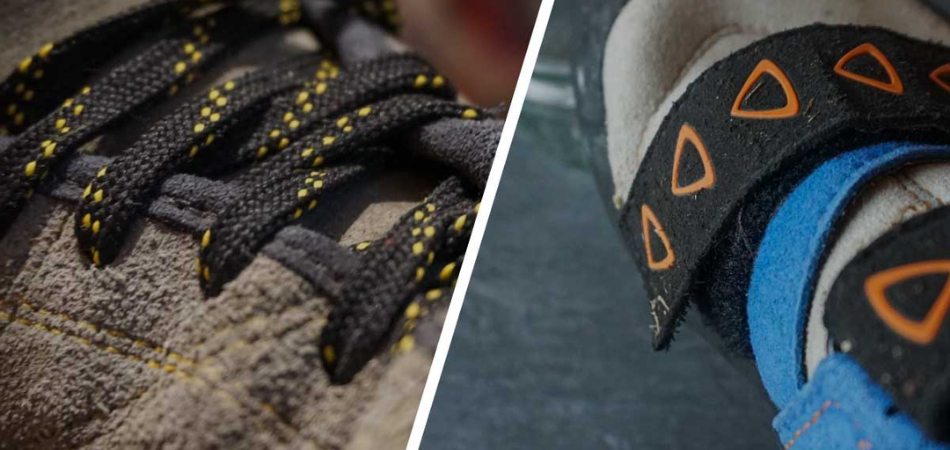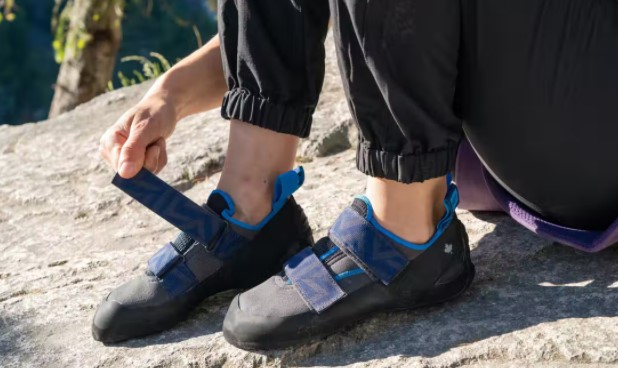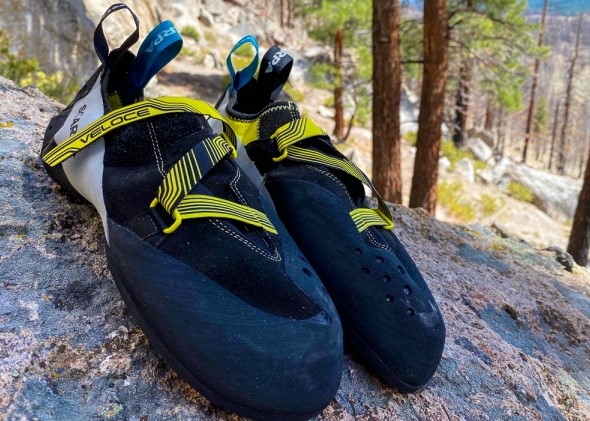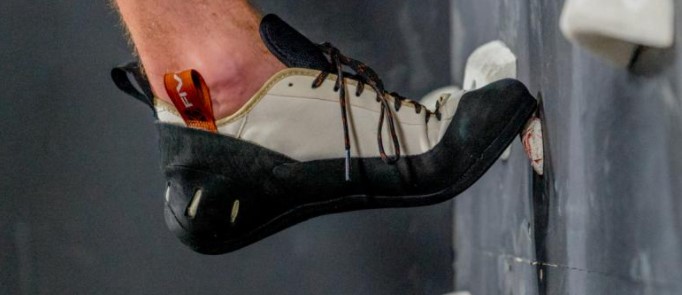There are two main styles of climbing shoes: those with velcro closures and those with laces. Each style has its own pros and cons, but at the end of the day, one style isn’t inherently any better than the other – it all comes down to personal preference.
In this article, we’ll cover the benefits and potential drawbacks of both styles, so you can make an informed decision about whether you are Team Velcro or Team Laces.

Benefits of Velcro Climbing Shoes
Velcro climbing shoes typically have between one and three straps that you can tighten down to hold the shoe on your foot. Some velcro climbing shoes have complex Z-shaped straps while others have simple straight-across straps.

Easy On and Off
The biggest benefit of velcro climbing shoes is that they are considerably easier to get on and off when compared to lace-up climbing shoes. Especially when your fingertips are raw after a gnarly climb, you don’t have to fiddle with tiny knots or pull each pass of the laces tight or loose. And, especially if you have very tight climbing shoes, it can be such a relief to rip the velcro open and have your shoes off in a matter of seconds.
More Convenient for Bouldering, Gym Climbing, Sport Climbing
In bouldering, gym climbing, and single-pitch sport climbing, there’s honestly a lot of standing around in between climbs or while you are belaying your partner. With velcro climbing shoes, you can easily pop them on when it’s your turn to climb and then slip into your comfy approach shoes or Chacos once you’re done.
Great for Kids
Especially for little kids who haven’t yet mastered the art of tying their own shoes, velcro climbing shoes can be a huge lifesaver. They are easy for kiddos to get on and off and adjust themselves without having to pester you that their shoes are too tight or too loose, or needing help taking their shoes on or off every five minutes.
Velcro is Less Prone to Wear
Finally, velcro doesn’t wear out nearly as quickly as shoelaces, which means less maintenance on your climbing shoes.
Drawbacks of Velcro Climbing Shoes
However, there are a few cons for velcro climbing shoes as well:

Less Adjustable
Velcro climbing shoes offer less adjustability since there’s usually only up to three straps at maximum, which means only three points of adjustments. Some shoes with the fancy Z-strap are even less adjustable – they are basically either tight or not tight. However, with the way that climbing shoes fit (aka very tight and close to your foot), this typically isn’t a serious issue unless you have an unusual foot shape or you are very particular about which part of your climbing shoe should fit tightly.
Can Become Less Effective When They Get Dirty
Velcro straps can become less effective when dirt gets into the loops and hooks, so take care to avoid grinding dirt into your climbing shoe straps. With some basic care and proper storage of your climbing shoes, you can avoid this scenario altogether. However, if your straps do get dirty and don’t hold as well, it’s much harder to replace velcro than it is to replace laces.
Benefits of Lace-up Climbing Shoes
Lace-up climbing shoes typically have laces that run from your toes to your ankle – with many more gromets than a street shoe.

More Adjustable Fit
This longer lace area allows for greater control over the fit of your climbing shoes, as you can tighten or loosen each section of the shoe almost independently of the other sections. Basically, laces allow you to micro-adjust the fit of your shoes while velcro only allows for macro-adjustments.
Generally Better for Crack, Trad, and Multi-Pitch Climbing
Lace-up climbing shoes are typically better-suited to crack, trad, and multi-pitch climbing. In crack climbing (and essentially all trad climbing is crack climbing), you will be jamming your feet into narrow spaces, and laces offer a lower profile than velcro straps. Velcro can also be ripped open as you stuff your foot into a skinny crack, and then you’ll have to stop and re-strap your shoes – big inconvenience.
In multi-pitch climbing, you’ll probably be on the wall for quite a while, so having the ability to micro-adjust your shoes will keep you comfortable for the long climbing session.
Drawbacks of Lace-up Climbing Shoes
There are a couple of drawbacks for lace-up climbing shoes as well:

Harder On and Off
Especially if you’ve got your laces cranked down tight and double-knotted, it can be a struggle to get your shoes off after a climb, especially when your fingers are tired and raw. Putting them on and getting the laces adjusted perfectly also takes significantly more time than slapping a few velcro slaps closed, so it’s less practical to take your lace-up shoes on and off in between bouldering attempts or gym climbs.
Laces Can Wear or Break
Laces can also wear and eventually break, which means you’ll need to replace them. However, this is a relatively cheap and easy process, and it can extend the life of your favorite climbing shoes significantly. However, if your laces break in the middle of a multi-pitch climb, you might find yourself trying to relace a shoe while dangling in your harness hundreds of feet off the ground, which can be less than ideal.
Frequently Asked Question
Are velcro shoes better than laces?
It depends on your personal preference! Some people swear by velcro shoes while other people won’t even consider purchasing climbing shoes unless they have real laces. As you can see above, there are pros and cons to each style and it really depends on the type of climbing you’ll be doing and your specific needs.
Do better climbing shoes make a difference?
Buying more high-tech climbing shoes will not automatically make you a better climber, but good shoes can help you develop your footwork technique. If you are a brand new climber, it’s not worth spending hundreds of dollars on climbing shoes – start with an entry-level pair and then when those wear through, you can think about upgrading.
What are the loops on climbing shoes for?
The loops on the back of climbing shoes are to help you pull them onto your feet. Once you go and actually try on a pair of climbing shoes, this will make sense – they typically fit snugly and very close to your foot, so having those pull loops makes it much easier to stuff your feet in there. Plus, you can stick a carabiner through the loops and attach your shoes to the outside of your backpack on the hike back to your car after a climbing session to help your shoes dry out properly and smell less.
What do you do with laces on climbing shoes?
The laces on your climbing shoes are used like any other shoelaces: to hold your shoes on your feet and allow you to adjust the snugness. Climbing shoes have laces that run all the way down to your toes, so you can adjust the tightness of each zone of the shoe to fit your foot perfectly.
Why do you not wear socks with climbing shoes?
You can wear socks with climbing shoes if you really want to or if you are climbing in a very cold environment, but most people do not wear socks because they reduce your ability to feel the holds with your toes, and they can allow your feet to move around too much within the shoe. Plus, climbing shoes should fit snugly, so wearing socks will likely make correctly sized shoes feel much too tight and uncomfortable.
